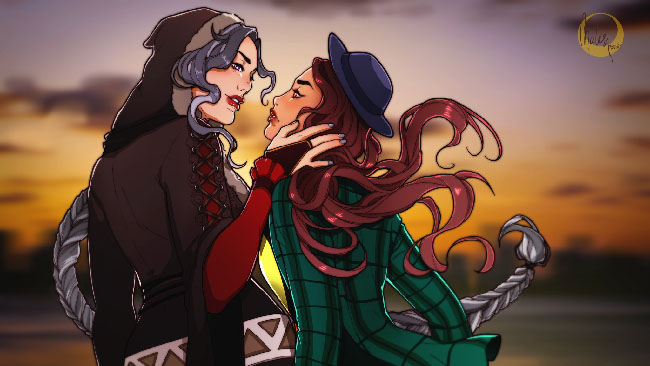The only option left to save the forest is to use your magic to make the trees defend themselves. You can do that, it’s within your power—but can you still do that knowing the enchanted trees will violently protect themselves against the loggers that try to cut them down, people who are just doing their jobs?
That is one of the supernaturally-charged moral dilemmas that the visual novel Wicked Willow wants to have players confront.

Developed by T.F. Wright, Wicked Willow is currently raising funds on Kickstarter. The campaign’s already hit its target goal, and has several stretch goals left. They include extra features like extended epilogues, an alternative story path, animated cutscenes, and an original song by singer Anastasia “Emphavoice” Ramanenka.
Wicked Willow will be Wright’s second game, following on the heels of his first one, The Pirate’s Fate.
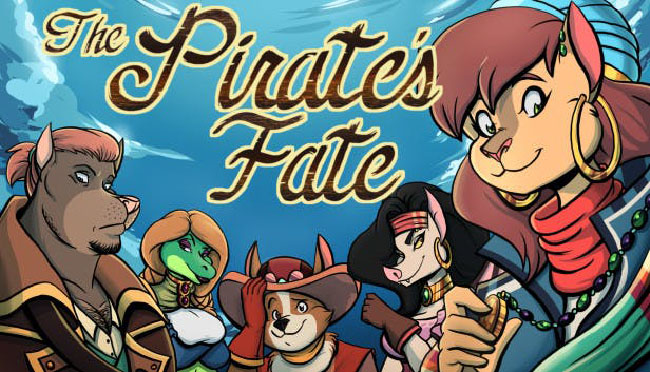
Though both visual novels, The Pirate’s Fate followed anthropomorphic characters on high seas adventures, while Wicked Willow will have a ‘90s human cast dealing with magic. The new project’s story focuses on Willow—the game’s eponymous protagonist—as she learns how to harness her magical potential.
Before Wicked Willow’s Kickstarter reached its target goal, Cliqist was able to chat online with Wright about the new project, going from activism to game development, taking inspiration from Life is Strange, and the virtues of Fallout: New Vegas.
Cliqist: Could you please tell us more about yourself?
T.F. Wright: I am an author, a game developer. Before that, I worked in politics as an organizer and fundraiser for progressive and LGBT causes. I have an MA in political science. I live in LA.
Did your previous work in activism, academia, and other publishing projects influence your current work with game development? And if so, how?
Yes, it did. In many ways.
Part of Wicked Willow is the history of the LGBT rights struggle. And I played a small role in that living history. So that informed my perspective.
[For something] a bit more technical…
I studied the philosophy of Paul Feyerabend in grad school. He argued against the establishment of lines of demarcation—hard rules—in the sciences. His philosophy was the only rule is that there are no rules, when it comes to knowledge.
I want to apply that perspective to morality with Wicked Willow. There is no absolute right and wrong. There are only our limited perspectives. Trying to do what’s right when there isn’t a “correct” answer is a huge part of the story experience.
It sounds like the game will be pretty gray in terms of morality then.
Yes. I want the player to empathize with Willow’s struggle as she debates what to do. And I want each choice to be a justified, valid option.
Has this been difficult to do? To generate empathy and justification for every choice?
I tried to do that, to a lesser degree, in my first game, The Pirate’s Fate. It is challenging.

However, I have some new strategies this time around. For example, there are no villains and no allies. Different characters will take on different roles depending on what choices you make.
So the complex choices will relate to equally complex characters, who have their own perspectives.
How do you approach creating the characters and their relationships with each other in Wicked Willow?
I want each character to have secrets, to have sides of them that you won’t be able to explore unless you really get to know them. Each path will focus on your relationship—friendship or romantic—growing closer with different people…
Instead of dating sims, where love feels like a puzzle to solve, relationships in Wicked Willow evolve and progress organically as the story unfolds.
In terms of creating the characters, I have tried to make each character have unique elements…
For example, I am not sure if you are familiar with Rodnovery. It is similar to a Renaissance fair in the west; it is a celebration of the pre-Christian traditions of Slavic Europe.
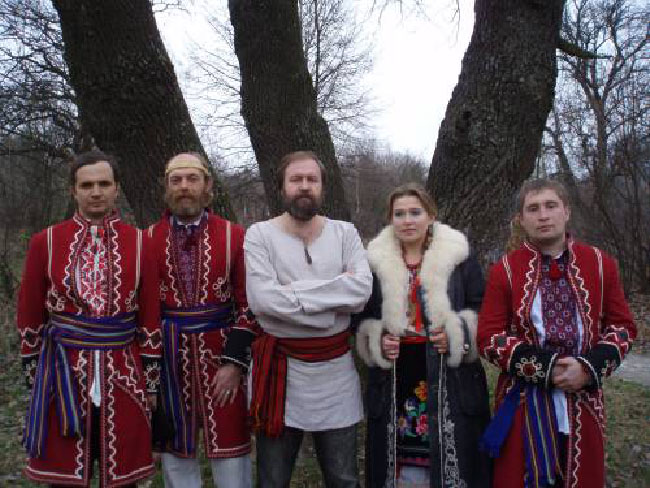
T.F. Wright shared this photo when explaining Rodnovery.
Tanya [Willow’s mentor], who is an immigrant from Eastern Europe, has a very similar costume design—although this picture [shared above by Wright] wasn’t used as a reference for this purpose.
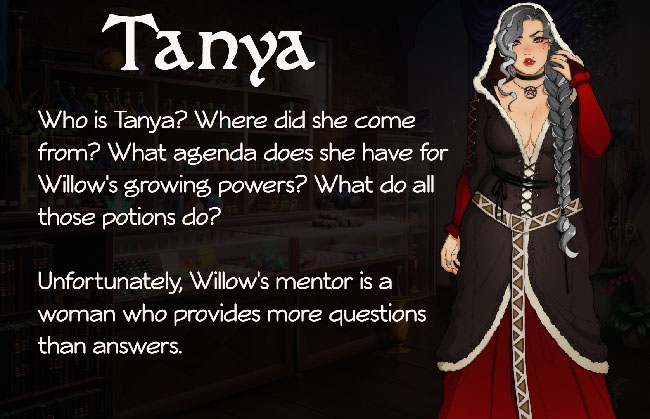
Do you draw inspiration from other cultures for Wicked Willow?
In a sense, yes. The game takes place in the United States.
However, different characters have different ties to different elements of culture. Tanya is an immigrant from Eastern Europe. Shadow comes from the UK. Avery is a part of the “nerd” culture with D&D, while Lydia is an Evangelical Christian. Willow is more a hippie type person. She is also a biracial person and her relationship with her heritage and family will be something that is explored as the story progresses.
You said the game will include some history on LGBT rights. How do you plan to balance history with fiction in the game?
It’s magical realism—the game is set in the real world of 1993, but there’s also some people who can use magic.
The characters have to deal with the problems and intolerance of their time, and they all deal with it in different ways.
Could you talk about your reasons for naming the game, “Wicked Willow?” Or would that be a spoiler?
I wanted the player to have the experience of being a “wicked witch,” but I also wanted to turn that concept on its head.
In the closing lines of the trailer, Tanya says, “if they call me wicked for following my heart, then so be it,” an allusion to the gay rights element.
How did you transition from organizing and fundraising for activism to making games? How did you get into game development?
So, I didn’t really enjoy fundraising and organizing all that much in practice. I believed in the cause, but the work itself became very repetitive and sales-like after a while.
I went back to school to get my MA, with the hopes of working at a research institute or think tank later. While I was in school, I read about a woman who made a full-time income publishing short stories on Amazon.
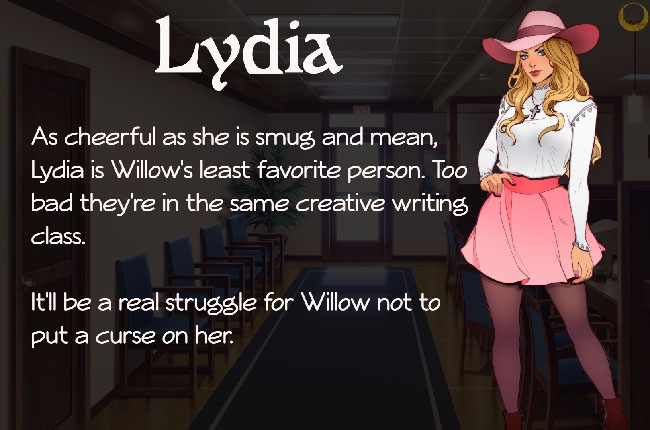
By that time, I’d already turned semi-professional with my own short stories, doing commissions and the like. So I was inspired to do my own stories, and started doing that while in grad school. Writing ended up being more fun and fulfilling than my previous work, so I continued that.
In 2015, Amazon changed their pay policies in ways that made it more difficult for authors of short stories to earn money. After that, I decided it might be time to try something new, and that lead to creating a visual novel game.
What was it like to transition from writing short stories to writing games?
Very difficult! What I really enjoy is inner monologue and body language. For The Pirate’s Fate, I did not include these. It was 100 percent dialogue, just like a screenplay.
For Wicked Willow, I have decided to include them, because the game will be narrated by Willow. A key difference is that Willow is a very distinct character, whereas Mila [protagonist of The Pirate’s Fate] was created to be a blank slate that evolved with the player’s choices. So I think I can give Willow a unique “voice” that the player can get to know.
I hope this creates a more immersive experience. It will also allow me to flex my strongest muscles as a writer.
Why make visual novels? What draws you to that game genre? Was it because of the writing potential?
Yes, that is one reason. Another: I had to teach myself to code to make my first game. So my expertise was limited. And the VN genre does not demand coding knowledge in the way other genres do.
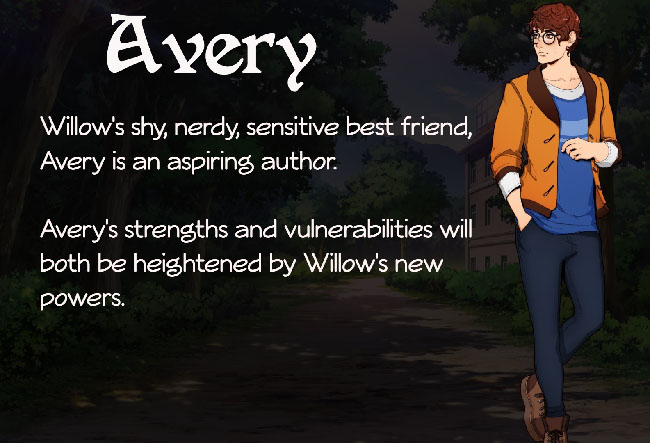
How did you assemble your development team for Wicked Willow? Have you worked with some—or all of them—before?
The team was all new. It took quite a lot of effort to find people. Some of them were the result of sending out emails asking for help. Some came to me.
I recently met a voice actor—who is also my composer—because I was trying to spread the word via Twitter and Discord.
What did you look for in a team?
My goal was to recruit talented, passionate people who believed in the project. I also wanted to help make sure that there was diverse representation, especially considering the fact that the story deals with the struggles of those with traditionally marginalized identities.
Did you study other Kickstarters and crowdfunding campaigns when making yours for Wicked Willow?
Yes. I think that Kickstarter is not really about raising money. Since a successful Kickstarter takes so much time and money in order to accomplish, it is about raising awareness, and seeing if the product is connecting with people. It is a test run of your actual launch.
The response I have received to Wicked Willow has been very positive, so I am happy there.
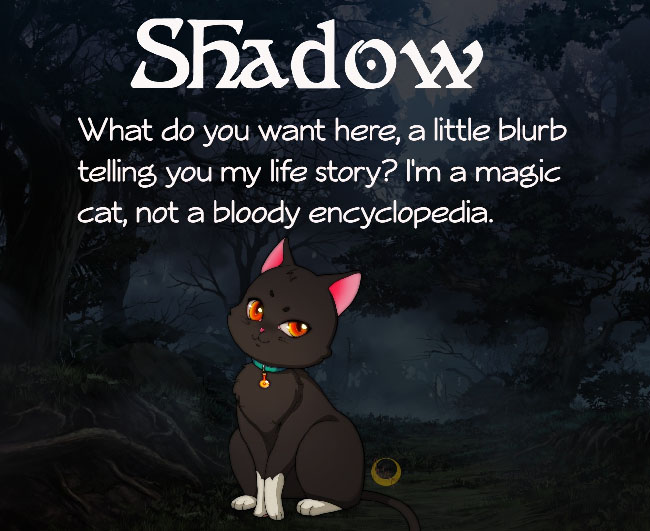
What are your hopes for the game?
I hope to create a powerful, emotional journey that will impact the way people see the world. I want to help create a story that will contextualize the civil rights struggle of my generation, the LGBT struggle. I want to create a story that celebrates the value of difference and diversity.
I don’t see this as only entertainment, I see storytelling as a way to have a positive impact on the world.
How did you decide on your approach to a branching storyline and player choice, as discussed in your Kickstarter’s video? Was it based on evolving from what you did in The Pirate’s Fate and other common visual novel themes? Or something else?
Yes, I decided to do that after the experience with The Pirate’s Fate… I thought what I did was good, but the permutations made it difficult.
I came up with the system [for Wicked Willow] in order to have lots of impactful choices without making the game feel short.
Honestly, most visual novels don’t even attempt to solve this. Most either have no choices or they have choices that don’t matter except for endings.
Detroit Become Human is an example of a really innovative system. But that one is so ambitious, that I’m not sure I could have done something similar.
Are there other games you look to for inspiration? Other things that inspire your work?
I think Life is Strange did a great job. The storytelling is amazing, the characters are very compelling, and the gameplay mechanic is a good way of creating immersion with Max’s powers.
I do think that the actual choice mechanics were a bit weak, though, because almost none of the choices actually matter, and the story is completely linear.
Tone-wise though, Life is Strange is exactly where I want to be.

One of the Kickstarter’s stretch goals is to create more content of Xarsi the succubus, who is currently the newest character to the game.
Do you have any favorite games? Any favorite visual novels?
My favorite game to play casually is Hearthstone… My favorite visual novel—if Life is Strange does not count—would be Escape from the Princess, which is another indie game. They have a story with multiple branches and an evolving relationship between the characters, which I like, as well as some good plot twists.
Would you say Life is Strange is your favorite game overall?
I think so, yes. It’s absolutely my favorite story game. Another one which jumps to mind, although it is a totally different genre, is Fallout: New Vegas.
That game has a pretty good story, non-linearity, as well as 4 different “factions” to pick which have their own very different yet justifiable moral compasses. It was a very immersive and fun experience.
How has working on Wicked Willow differed from developing your first visual novel, The Pirate’s Fate?
So first of all, I wrote an article which answers that question! Beyond what I wrote in that article, there are a few differences…
First, I’m doing a lot more community engagement. With The Pirate’s Fate, we kind of just threw out art and stuff, and hoped people came to us.
But I’m trying to cultivate a Discord community for fans of Wicked Willow, and I’m doing regular voice chats with them now.
The games also have a different focus. TPF had a lot more focus on body positivity. That’s still an element of Wicked Willow, but now I’m more focused on identity, sexuality, and morality.
How are you approaching magic in Wicked Willow? What inspires your treatment of it in the game? Your Kickstarter said that magic will have consequences in Wicked Willow.
Magic will not be something easy to use. Each use will require effort, and will cause a large ripple in the world around you. Not directly—it’s not as though you make yourself invisible and then a roof flies off. It is more the consequences of your actions.
In the Kickstarter, I gave the example of turning trees into monsters to save a forest from clearcutters. What if that is the only way to save the forest? Are you willing to potentially endanger the lives of the loggers?
That’s the goal. Magic is kind of a metaphor for all actions which have consequences. It just magnifies the impact we have on the world around us. Understanding where magic comes from or how it works isn’t a huge focus. Instead, the focus is, “how can we use it wisely?”
Is there more you can share about Wicked Willow and its future without going into spoiler territory?
Well, I’m working on trying to do some really exciting things…
For example, I have the Secret Journal, which is supposed to be the lore companion to the game. Today I talked to someone about potentially having it be done in a motion-book style, kind of like an animated comic. If we can do that, it will be a really fun way to introduce people to the story.
Thank you for taking the time to talk about Wicked Willow.


